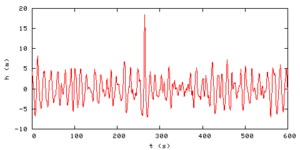
Draupner wave
Encyclopedia


Measuring instrument
In the physical sciences, quality assurance, and engineering, measurement is the activity of obtaining and comparing physical quantities of real-world objects and events. Established standard objects and events are used as units, and the process of measurement gives a number relating the item...
, occurring at the Draupner platform
Draupner platform
The Draupner platform is a complex consisting of the Draupner S and E riser platforms in the North Sea. It is located in the Norwegian North Sea block 16/11 offshore Norway. The complex consists of seven risers and two riser platforms standing in water depth and linked by a bridge...
in the North Sea
North Sea
In the southwest, beyond the Straits of Dover, the North Sea becomes the English Channel connecting to the Atlantic Ocean. In the east, it connects to the Baltic Sea via the Skagerrak and Kattegat, narrow straits that separate Denmark from Norway and Sweden respectively...
off the coast of Norway
Norway
Norway , officially the Kingdom of Norway, is a Nordic unitary constitutional monarchy whose territory comprises the western portion of the Scandinavian Peninsula, Jan Mayen, and the Arctic archipelago of Svalbard and Bouvet Island. Norway has a total area of and a population of about 4.9 million...
on January 1, 1995. Prior to this measurement, such freak waves were known to exist only through anecdotal evidence
Anecdotal evidence
The expression anecdotal evidence refers to evidence from anecdotes. Because of the small sample, there is a larger chance that it may be true but unreliable due to cherry-picked or otherwise unrepresentative of typical cases....
provided by those who had encountered them at sea.
Minor damage was inflicted on the platform during this event, confirming the validity of the reading made by a downwards-pointing laser sensor. In an area with significant wave height
Significant wave height
In physical oceanography, the significant wave height is defined traditionally as the mean wave height of the highest third of the waves , but now usually defined as four times the standard deviation of the surface elevation...
of approximately 12 metres (39.4 ft), a freak wave with a maximum wave height
Wave height
In fluid dynamics, the wave height of a surface wave is the difference between the elevations of a crest and a neighbouring trough. Wave height is a term used by mariners, as well as in coastal, ocean and naval engineering....
of 25.6 metres (84 ft) occurred (peak elevation was 18.5 metres (60.7 ft)). Engineer Paul Taylor estimated the Draupner wave was a one in 200,000 wave.

